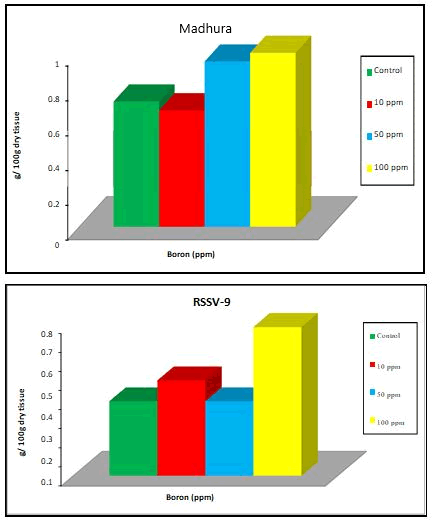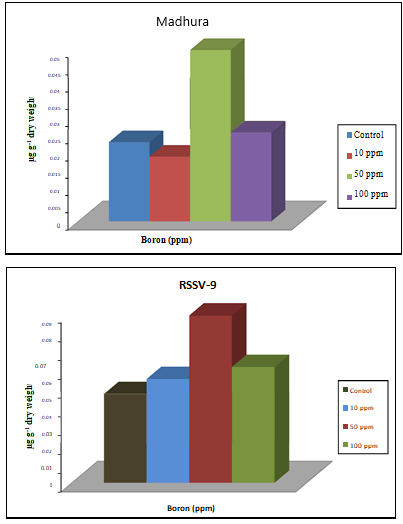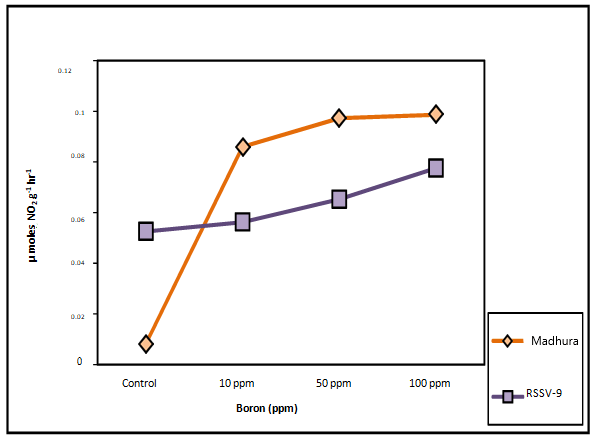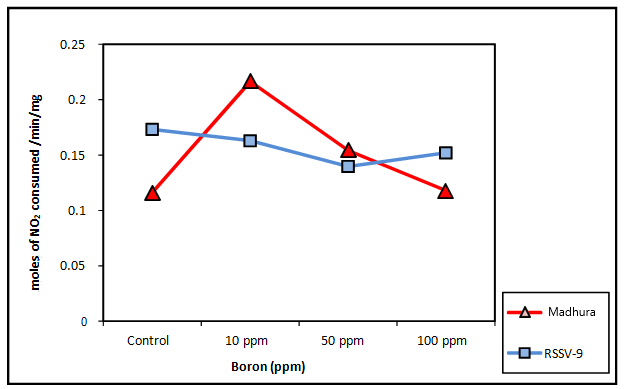Research Article, J Plant Physiol Pathol Vol: 11 Issue: 6
Effect of Boron on the Nitrogen Metabolism in Sweet Sorghum (Sorghum bicolor L.)
Sujeet Jadhav*Department of Biochemistry, Shivaji University, Mhaswad, Maharashtra, India
*Corresponding Author: Sujeet Jadhav, Department of Biochemistry, Shivaji University, Mhaswad, Maharashtra, India, Tel: 9011032356; E-mail: jsujeet27@gmail.com
Received date: 08 March, 2022, Manuscript No. JPPP-22-56495;
Editor assigned date: 11 March, 2022, PreQC No. JPPP-22-56495 (PQ);
Reviewed date: 25 March, 2022, QC No. JPPP-22-56495;
Revised date: 09 May, 2022, Manuscript No. JPPP-22-56495 (R);
Published date: 16 May, 2022, DOI:10.4172/2329-955X.10000125.
Citation: Jadhav S (2022) Effect of Boron on the Nitrogen Metabolism in Sweet Sorghum (Sorghum bicolor L.). J Plant Physiol pathol 10:6.
Abstract
Boron is an important trace element required for the different physiological functions in plants. Boron is involved in nitrogen, carbohydrate metabolism in plants. Nitrogen activity has been increased due to adequate boron supply in plants. The experiment was carried out on two varieties of sweet sorghum (Sorghum bicolor L). Sweet sorghum is an important staple food in semi-arid areas. Pot culture technique was conducted triplicate for this experiment. The study was carried to analyze the relation between nitrogen uptake and allied enzyme activity due to different concentrations of boron. In the present investigation the effect of different boron concentrations like 0 ppm (Control), 10 ppm, 50 ppm and 100 ppm on sweet sorghum var. RSSV-9 and Madhura have been studied. The data was collected after the full growth of the plant. The results are showing that total nitrogen and nitrate content is increased due to boron treatment. The enzymes involved in nitrogen metabolism like Nitrate Reductase (NR) activity and Nitrite Reductase activity (NiR) have also been increased due to boron treatment. The results are suggesting that adequate boron supply to the sweet sorghum may increase nitrogen metabolism in sweet sorghum. The objective of the experiment is to identify the correct dose of boron for nitrogen metabolism in sweet sorghum. The correct dose of boron is helpful to understand the interaction with nitrogen which is an effective method to improve the sustainability and productivity of sweet sorghum.
Keywords: Sweet sorghum; Boron; Enzymes; Nitrate reductase; Nitrite reductase
Introduction
Nitrogen is one of the most important primary plant nutrients, next to water. It is an essential component of all biomolecules including proteins, chlorophylls and vitamins. Nitrogen is needed in large quantities and must be in balance with other nutrients. Nitrogen is converted into amino acids inside the plants and these amino acids then used in formation of protoplasm that is used in cell division. Similar amino acids are also used in producing necessary enzymes and structural parts of plants. Thus, nitrogen can become part of stored proteins in the grains. To get optimum growth and development of plants, carbon and nitrogen metabolism pathways are very important which are regulated by complex mechanisms and which determines the amount of protein stored in cereal grains [1]. According to the movement of nitrogen from the soil to all the cells of plant, involves numerous transport and metabolic processes which includes nitrogen uptake and partitioning within cells and over short and long distances, and nitrogen (re) assimilation, amino acid synthesis and catabolism, and protein synthesis [2].
Boron is one of the microelements required for healthy crop growth and development of reproductive tissues. It is required in a very small amount. However, the deficiency and excess use of boron may affect crop growth. Boron is important micronutrient which plays role in improving yield and enhance its availability for sustainable development of the plants [3]. The work done by states that soil applied boron improves growth and yield of cotton grown on calcareous saline soil [4]. As boron is important micronutrient required for plant growth and yield which play vital functions in cell wall formation, nitrogen fixation, nucleic acid, membrane stability, sugar transport, and carbohydrate and indole acetic acid metabolism [5]. Due to all these roles, boron leads to an increase in plant height and production [6,7]. The application of B (fertilizers) in different rice-based systems helps to increase crop productivity by reducing yield losses, enhancing milling return, and improving cooking quality [8]. Together with the knowledge of the physiology and genetics of boron, should result in the development of efficient and tolerant varieties that may represent a long-term sustainable solution for the problem of inadequate or excess boron supply [9].
Sorghum bicolor is an important dry land annual cereal crop grown in India. It is the fifth most important cereal grain after maize, rice, wheat and barley in the world [10]. It is a main staple food in arid and semi-arid areas. In semi-arid tropics when other plants fail to survive, sweet sorghum can grow successfully. In tropical, subtropical, temperate, semiarid region and in poor quality soil, it can be easily grown. It can be cultivated in kharif, ruby and summer seasons. Sweet sorghum is said to be valued for 4-F’s. These 4-F’s are food, feed, fuel and fertilizer. It can produce along with grains, a sugary juice that is useful to produce ethanol, jaggery, syrup and flour. As sweet sorghum produces food as well as fuel, it can help to meet the country's fuel needs without compromising our food supply. This plant can compete with sugarcane for ethanol production as sugarcane requires comparatively more water, fertilizers and has a long lifespan also. The purpose of selecting this crop for the study as this plant requires minimum water and fertilizers and can grow in semi-arid areas also.
The present study was carried out to establish the behavior of nitrogen metabolism due to different boron concentrations in two sweet sorghum cultivars ‘RSSV-9’ and ‘Madhura’. The effect of boron was studied by assessing changes in nitrogen metabolites and in activities of key nitrogen-assimilating enzymes. Knowing the effect of boron on nitrogen metabolism in these cultivars will shed new understanding about how biochemically and physiologically these cultivars succeed in maintaining optimum productivity. Thus the objective of this study is to know the proper dose of boron in sweet sorghum as sweet sorghum is important for food as well as feed and fuel in semi-arid areas.
Materials and Methods
The sweet sorghum varieties RSSV-9 and Madhura were grown in individual pots which were treated with 10 ppm, 50 ppm and 100 ppm boron along with one pot untreated i.e. 0 ppm named as control. These treatments were given at 15 days old seedlings and the treatment was repeated at 40 days and 70 days old plant after sowing. The pot culture technique was used for the experiment with three replications. The individual pot of the size 2 x 3 feet in size with two feet depth was used for experiment. Every pot was filled with 25 kg black soil approximately and two kg of organic manures were added to it. The soil selected was analyzed. The soil having pH 6.7 and 0.0339 ppm boron was naturally present in it. There were three treatments of boron with different concentrations along with one control pot without any treatment. At maturity plants from each treatment and control were harvested and total nitrogen, nitrate content and enzymes related to nitrogen metabolism were estimated according to various popular methods.
Total nitrogen was estimated according to a method given by Hawk, et al. from the leaves of treated and control plants of both the cultivars of sweet sorghum. The nitrate content of the leaves from treated plants was estimated following the method given by Kolhoff and Noponen [11]. In vivo activity of enzyme Nitrate reductase and Nitrite reductase in treated and non-treated plants was determined by the following method by Jaworsky [12].
Result and Discussion
The influence of boron on total nitrogen content of sweet sorghum cultivars is depicted in Figure 1. The nitrogen content of both the cultivars is increased by boron treatments except due to 10 ppm boron treatment in c. v. Madhura and 50 ppm boron in c. v. RSSV-9. The enhancement in nitrogen content is observed due to 100 ppm boron doses in both the cultivars.
Nitrogen is one of the most important primary plant nutrients, next to water. It is an essential component of all biomolecules including proteins, chlorophylls and vitamins. Nitrogen is needed in large quantities and must be in balance with other nutrients. Nitrogen occurs in all organisms, primarily in the amino acids which are the building blocks of proteins like porphyrin, cytochrome which are essential in respiration and photosynthesis respectively. Nitrogen is converted into amino acids inside the plants and these amino acids then used in formation of protoplasm which is used in cell division. Similar amino acids are also used in producing necessary enzymes and structural parts of plants. Thus nitrogen can become part of stored proteins in the grains. Nitrogen is a part of chlorophyll, which is associated with production of simple sugars from solar energy. Nitrogen is present in the plants as a dark green color.
Boron plays a pivotal role in Nitrogen (N) metabolism as it enhances nitrate levels and reduces nitrate reductase activity under limited boron conditions. A study by Bolanos, et al. has also highlighted the role of boron in rhizobial nitrogen fixation, actinomycetes symbiosis, and cyanophyceae heterocyst formation in leguminous crops [13]. Sweet sorghum requires less nitrogen as compared to other biofuel crops like sugarcane [14]. Several reports also indicate that boron may affect the genes in their expression level related to nitrogen metabolism [15]. Boron is responsible for minor changes in plants which affect nitrogen metabolism positively [16]. Boron deficiency causes lower net absorption rate due to decline in the activity of protein carriers of NO3- which results in lower concentration of NO3-. The effect of boron on nitrogen metabolism is due to positive influence on enzymatic protein synthesis and secondly by promoting the entrance of substrate through plasma membrane to the interior of cell [17]. Ahmad et al. have studied the impact of boron on cotton and found that nitrogen concentration increases with increasing levels of boron [18]. The reports of El- Feky, et al. showed decline in nitrogen due to high boron concentration [19].
Our results show that boron increases nitrogen in plants which ultimately benefited to nitrogen metabolism under boron stress conditions for the improvement of crop.
The effect of boron concentrations on total nitrate content on c. v. Madhura and c. v. RSSV-9 is depicted in Figure 2. The total nitrate content is increased due to 50 ppm and 100 ppm boron treatments in both cultivars i. e. Madhura and RSSV-9. However, there is slight decline in nitrate content due to low doses of boron like 10 ppm in both the cultivars studied.
Nitrate content: Nitrate is the main source of nitrogen for any plant growing in various conditions. The major organic nitrogen in the biosphere is derived from nitrate. The higher plants generally mitigate their nitrogen requirement through nitrate, as they are not able to directly absorb the available nitrogen from the atmosphere. The available nitrogen is converted into nitrate and it is reduced to ammonia and then it is available to plants in the organic form inside the soil [20].
There are several reports on the possible involvement of boron in nitrogen assimilation. There are several reports on the possible involvement of boron in nitrogen assimilation. The higher nitrate assimilation under normal levels of boron is a result of either increased synthesis of proteins involved in the process or due to availability of nitrate absorption [21]. The foliar application of boron increases nitrate uptake or translocation of nitrate from vacuoles to cytoplasm [22].
In the present investigation, boron treatments with 50 ppm and 100 ppm concentrations have shown significant increase in total nitrate content. It is because boron enhances nitrate assimilation as reported earlier by Bellaloui, et al.
The effect of boron treatment on nitrate reductase activity in sweet sorghum cultivars is shown in the Figure 3. The NR activity is increased as boron treatment is increased in both the cultivars studied. This increment in enzyme activity is noticeable in c. v. Madhura than c. v. RSSV-9. The maximum NR activity was reported by 100 ppm boron concentration in both cultivars.
Nitrate reductase: Nitrate reductase is a key enzyme of nitrogen metabolism. Nitrogen is available in the atmosphere but is not readily available to plants unless it is reduced in nitrate and then converted to ammonia. During this entire process nitrate reductase enzymes play a vital role in the reduction process. Nitrate reductases are molybdo enzymes that reduce nitrate (NO3-) to nitrite (NO2-) during the assimilatory process called nitrogen metabolism. NR when catalyzes the first step of nitrate assimilation, it appears to be a rate limiting process in nitrogen metabolism and generates NO2- in the cytoplasm of a plant cell which is translocate in to the plastids for further reduction and metabolization [23].
Boron may stimulate de novo synthesis and make nitrate available for the enzyme nitrate reductase. Both NR and nitrogenase enzymes developed in the nodule competing for reductant. The addition of boron to such a condition may increase NR activity in soybean plants. Boron may have an indirect effect on enhancing NR activity by nitrate uptake and assimilation. Bonilla, et al. [24]. also of the opinion that adequate levels of boron have increased NRA and decreased xylem sap. In sugar-beet, tomato, sunflower, corn and oilseed rape boron deficiency affects nitrate levels due to reduced activity [25].
Under non-saline conditions, the presence of excessive boron favored higher nitrate and ammonium mobilization to leaves, increasing Nitrate Reductase (NR) activity [26].
In the present study the NR activity is increased with increased boron treatment in both the cultivars to cope with the requirement of nitrogen under stress conditions as it plays an important role in the formation of functional protein by synthesizing essential amino acid residues.
The influence of boron on nitrite reductase activity in c. v. Madhura and c. v. RSSV-9 is shown in Figure 4. In c. v. Madhura all boron treatments increase NiR activity. 10 ppm boron treatment shows highest NiR activity followed by 50 ppm treatment. However, the c. v. RSSV-9 however shows decline in NiR activity due to all boron treatments and it is maximum at 50 ppm boron treatment.
Nitrite reductase (NiR): Nitrite reductase is the enzyme that reduces nitrite to ammonia. Nitrate transported to cells reduced by nitrate reductase in the cytosol while this nitrite is further reduced to ammonia by the second enzyme nitrite reductase (NiR) in the chloroplast, so most of the NiR activity was found in younger leaves of the plant. The reduction of nitrite to ammonia in plants due to nitrite reductase requires highly electronegative reluctance.
Very little work is done on the boron effect on NiR activity. The studies of Cervilla, et al. on tomato plants reveal that boron toxicity reduces NiR activity [27]. A significant increase in the Nitrate Reductase (NR) and Nitrite Reductase (NiR) activity in roots and leaves were noted. A study report on soybean shows boron toxicity significantly decreases NiR activity. The lowest NO3- and NH4+ concentration in leaves was recorded when plants were supplied with 2.0 mM B in the root medium. Further authors are of the opinion that total B, amino acids, activities of GS, GOGAT and GDH increased under B toxicity [28-31].
In the present investigation, both varieties act differently to boron treatment. In c. v. Madhura, the increment of NiR activity positively influences the conversion of NO2 to ammonia which further copes with the nitrogen requirement of Sorghum.
Conclusion
The nitrogen content of both the cultivars is increased by boron treatments except due to 10 ppm boron treatment in c. v. Madhura and 50 ppm boron in c. v. RSSV-9. The enhancement in nitrogen content is observed due to 100 ppm boron doses in both the cultivars. Our results clears that boron increases nitrogen in plants benefitted to nitrogen metabolism under boron stress conditions through nitrogen metabolism for the improvement of crop.
The total nitrate content is increased due to 50 ppm and 100 ppm boron treatments in both cultivars i. e. Madhura and RSSV-9. However, there is a slight decline in nitrate content due to low doses of boron like 10 ppm in both the cultivars studied. In the present investigation, boron treatments with 50 ppm and 100 ppm concentrations are showing significant increase in total nitrate content. Thus, it is helpful to the nitrogen requirement under boron treatment in both the cultivars under investigation.
The NR activity is increased as boron treatment is increased in both the cultivars studied. This increment in enzyme activity is noticeable in c. v. Madhura than c. v. RSSV-9. The maximum NR activity is reported by 100 ppm boron concentration in both cultivars. In the present study the NR activity is increased with increased boron treatment in both the cultivars to cope with the requirement of nitrogen under stress condition as it plays an important role in the formation of functional protein by synthesizing essential amino acid residues.
In c. v. Madhura, all boron treatments increased NiR activity. 10 ppm boron treatment shows the highest NiR activity followed by 50 ppm treatment. The c. v. RSSV-9 however shows the decline in NiR activity due to all boron treatments and it is maximum at 50 ppm boron treatment. In the present investigation both varieties respond differently to boron treatment. In c. v. Madhura the increment of NiR activity positively influences the conversion of NO2 to ammonia which further copes with the nitrogen requirement of sorghum.
References
- Mrid RB, Bouargalne Y, El-Omari R, El-Mourabit N, Nhiri M (2018) Activities of carbon and nitrogen metabolism enzymes of sorghum (Sorghum bicolor Moench) during seed development. J Crop Sci Biotechnol 21:283-289.
- Samantha VT, Rachel S, Mechthild T (2021). Targeting Nitrogen Metabolism and Transport Processes to Improve Plant Nitrogen Use Efficiency. Front Plant Sci 11:1-22.
- Shireen F, Nawaz MA, Chen C, Zhang Q, Zheng Z, et al. (2018) Boron: Functions and Approaches to Enhance Its Availability in Plants for Sustainable Agriculture. Int J Mol Sci 19:1856.
- Atique-ur-Rehman, Qamar R, Hussain A, Sardar H, Sarwar N, Javeed HMR (2020) Soil applied boron (B) improves growth, yield and fiber quality traits of cotton grown on calcareous saline soil. PLoS One 15:e0231805.
- Ali EA (2012) Effect of iron nutrient care sprayed on foliage at different physiological stages on yield and quality of some durum wheat (Triticum durum) varieties in sandy soil. Asian J Crop Sci 4:139-149.
- Masoud Bameri, Abdolshahi R, Mohammadi-Nejad G, Yousefi K, Tabatabaie SM (2012) Effect of different microelement treatment on wheat (Triticum aestivum) growth and yield. Int Res J Appl Basic Sci 3:219-223.
- Atique-ur-Rehman, Farooq M, Rashid A, Nadeem F, Stuerz S, et al. (2018) Boron nutrition of rice in different production systems. A review. Agron Sustain Dev 38:1-24.
- Brdar-Jokanovic, Milka (2020) Boron Toxicity and Deficiency in Agricultural Plants. Int J Mol Sci 21:1424.
- Kolthoff IM, Noponen GE (1933) Diphenylamine sulfonic acid as a reagent for the colorimetric determination of nitrates. J Am Chem Soc 55:1448-1453
- Jaworski EG (1971) Nitrate reductase assay in intact plant tissues. Biochem Biophys Res Commun 43:1274–1279.
- Bolanos L, Łukaszewski K, Bonilla I, Dale B (2004) Why boron? Plant PhysiolBiochem 42:907-912.
- Almodares A, Hadi MR (2009) Production of Bio-ethanol from sweet Sorghum-A review. Afr J Agric Res 4:772-780.
- Camacho-Cristobal JJ, Gonzalez-Fontes A (2007) Boron deficiency decreases plasmalemma H+- ATPase expression and nitrate uptake and promotes ammonium assimilation into asparagine in tobacco roots. Planta 226:443-451.
- Pavinto PS, Aguiar A, Castro GSA (2009). Boro em arroz de terras altas cultivado em solucao nutritiva. Bragantia 68: 743-751.
- Lopez -Lefebre LR, Rivero RM, Garcia PC, Sanchez E, Ruiz JM, et al. (2002) Boron effect on mineral nutrients of tobacco. J Plant Nutr 25:509-522.
- Ahmad N, Muhammad A, Fiaz A, Ullah MA, Javaid Q, et al. (2011) Impact of boron fertilization on dry matter production and mineral constitution of irrigated cotton. Pak J Bot 43:2903-2910.
- El-Feky SS, El-Shintinawy FA, Shaker EM, El-Din HAS (2012) Effect of elevated boron concentrations on the growth and yield of barley (Hordeum vulgare) and alleviation of its toxicity using different plant growth modulators. Aust J Crop Sci 6:1687-1695.
- Sivasankar S, Oaks A (1996) Nitrate assimilation in higher plants. The effect of metabolites and light. Plant Physiol Biochem 34: 609-620.
- Ruiz JM, Baghour M, Bretones G, Belakbir A, Romero L (1998) Nitrogen metabolism in tobacco plants (Nicotiana tabacum): Role of boron as a possible regulatory factor. Plant Sci 159:121-126.
- Bellaloui N (2011) Effect of water stress and foliar boron application on seed protein, oil, fatty acids, and nitrogen metabolism in soybean. Am J Plant Sci 2:692-701.
- Mazid M, Ali B, Hayat S, Ahmad A (2010) The effect of 4-chloroindole-3–acetic acid on some growth parameters in mung beans under cadmium stress. Turk J Biol 34:9-13.
- Bonilla I, Mergold-Villasenor C, Campos ME, Sanchez N, Perez H, et al. (1997) The aberrant cell walls of boron-deficient bean root nodules have no covalently bound hydroxyproline-/proline-rich proteins. Plant Physiol 115:1329-1340.
- Kastori R, Petrovic N (1989) Effect of boron on nitrate reductase activity in young sunflower plants. J Plant Nutr 12:621-627.
- Fuertes-Mendizábal, Teresa, Bastías EI, González-Murua C, González-Moro MB (2020) Nitrogen Assimilation in the Highly Salt- and Boron-Tolerant Ecotype Zea mays L. Amylacea. Plants 9:322.
- Cervill LM, Blasco B, Ríos JJ, Rosales MA, Rubio-Wilhelmi MM, (2009) Response of nitrogen metabolism to boron toxicity in tomato plants. Plant Biol 11:671-677.
- Hemantaranjan A, Trivedi AK (2015) Influence of Boron and Zinc on Nitrate and Nitrite Reductase Activity in Roots and Leaves, and Sulfur Containing Amino Acids, Protein and Oil Content in Seeds of Soybean Glycine Max (L.) Merr.] Int J Sci Res Sci Technol 1:30-38.
- Hawk PB, Oser BL, Summerson WH (1948). Practical physiological chemistry (Publ.). The Blockiston Co. USA.
- Lowry OH, Rosebrough NJ, Farr AL, Randall RJ (1951) Protein Measurement with the Folin Phenol Reagent. J Biol Chem 193:265-275.
- Moore S, Stein WH (1948) Photometric ninhydrin method for use in the chromatography of amino acids. J Biol Chem 176: 367–388.
- Ramon AM, Carpena- Ruiz RO, Garate A (1989) In vitro stabilization and distribution of nitrate reductase in tomato plants: Incidence of Boron deficiency. J Plant Physiol 135:126-128.
- Wojcik M, Klamkowski K (2008) Response of apple trees to boron fertilization under conditions of low soil boron availability. Sci Hort 116:58-64.
 Spanish
Spanish  Chinese
Chinese  Russian
Russian  German
German  French
French  Japanese
Japanese  Portuguese
Portuguese  Hindi
Hindi 




